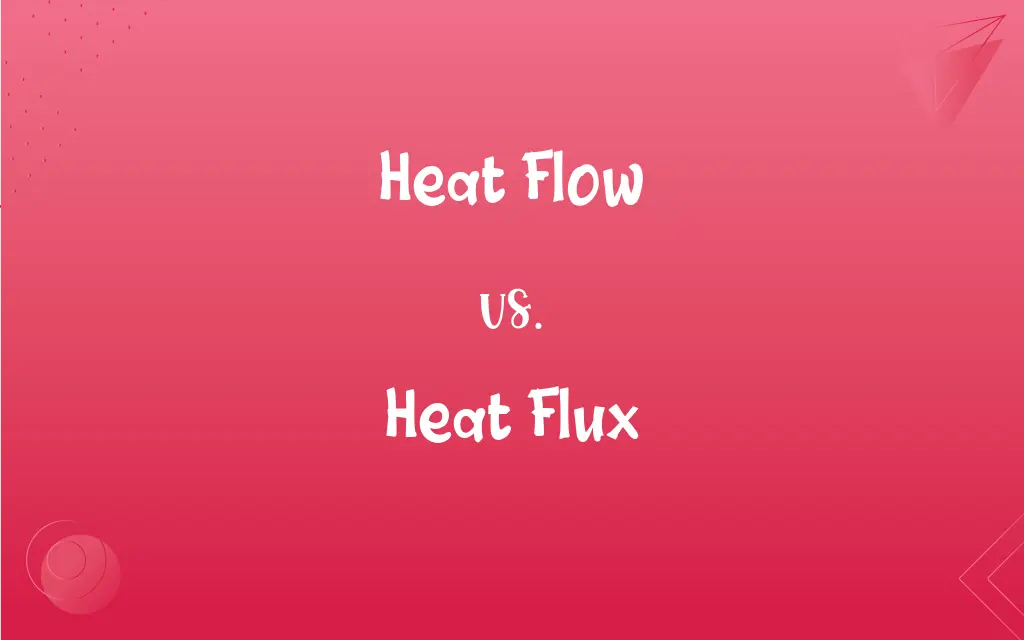Heat Flow vs. Heat Flux: What's the Difference?
Edited by Janet White || By Harlon Moss || Published on December 5, 2023
Heat flow is the transfer of heat energy from one place to another, while heat flux is the rate of heat transfer per unit area.

Key Differences
Heat flow represents the movement of thermal energy from a higher temperature region to a lower temperature region. Heat flux, on the other hand, quantifies this transfer rate per unit area, often measured in watts per square meter.
Heat flow is a concept that describes the transfer of thermal energy in terms of quantity. Heat flux is more specific, focusing on the intensity or density of heat transfer over a surface area.
The total heat flow in a system depends on the temperature difference and the thermal properties of the medium. Heat flux provides a more localized description, indicating how rapidly heat is being transferred at a specific location.
Heat flow is a broader term that can be applied to various scales, from microscopic to macroscopic systems. However, heat flux is crucial in understanding localized thermal phenomena and in the design of thermal management systems.
Heat flow gives a general idea of thermal energy movement, while heat flux is essential for detailed analysis in thermal engineering and material science.
ADVERTISEMENT
Comparison Chart
Definition
Transfer of heat energy between areas
Rate of heat transfer per unit area
Measurement
Total heat energy transferred
Heat energy transferred per unit area
Focus
Quantity of heat transfer
Intensity or density of heat transfer
Application Scale
Macroscopic and microscopic
Localized, surface-based analysis
Importance
General understanding of thermal energy
Detailed thermal analysis and management
ADVERTISEMENT
Heat Flow and Heat Flux Definitions
Heat Flow
Heat flow can occur through conduction, convection, or radiation.
The sun's heat flow warms the Earth through radiation.
Heat Flux
Heat flux helps in understanding localized heat distribution.
The heat flux map showed hot spots in the electronic circuit.
Heat Flow
Heat flow is the movement of thermal energy from a warmer to a cooler area.
In winter, heat flow from inside the house to the outside increases.
Heat Flux
It quantifies heat transfer per unit area.
In thermal imaging, high heat flux areas are highlighted.
Heat Flow
Heat flow describes the quantity of heat moving in a system.
Effective insulation reduces the heat flow from the building.
Heat Flux
It's a crucial measurement in thermal engineering.
Engineers calculated the heat flux to design a more efficient cooling system.
Heat Flow
It's the transfer of heat energy due to temperature differences.
The heat flow in the oven cooks the food.
Heat Flux
Heat flux is used to describe the intensity of heat transfer.
Heat flux was high near the furnace, indicating intense heat transfer.
Heat Flow
It's the process of thermal energy exchange in an environment.
Heat flow in the engine keeps it at an optimal operating temperature.
Heat Flux
Heat flux is the rate at which heat is transferred through a surface.
The heat flux through the walls was measured to improve insulation.
FAQs
What are the common methods of heat flow?
Conduction, convection, and radiation are the primary methods.
How is heat flow measured?
It is often measured in watts (W) or joules per second (J/s).
Does heat flow naturally from hot to cold or vice versa?
Naturally, it flows from hot to cold.
What is heat flow?
Heat flow is the transfer of thermal energy from a hotter region to a cooler one.
Can heat flow be reversed?
It cannot be reversed naturally; it always moves from hot to cold.
Is heat flow the same as temperature?
No, temperature is a measure of thermal energy, while heat flow is the transfer of that energy.
Is insulation related to heat flow?
Yes, insulation materials are used to reduce heat flow.
Is heat flow important in building design?
Yes, for energy efficiency and comfort, controlling heat flow is crucial.
What is heat flux?
Heat flux is the rate of heat transfer per unit area.
Does heat flux depend on material?
Yes, different materials will have different heat flux values under the same conditions.
Can heat flow occur in a vacuum?
Yes, by radiation, as it doesn't require a medium.
What affects the rate of heat flow?
Material properties, temperature difference, and surface area affect it.
How does heat flux relate to temperature gradient?
Higher temperature gradients generally result in higher heat flux.
Can heat flux be negative?
In terms of direction, yes, indicating heat transfer in the opposite direction.
Can we control heat flux?
Yes, through the use of insulators, conductors, and varying the surface area.
What is an example of heat flux?
Solar radiation on the Earth's surface is a common example.
Is heat flux important in thermal engineering?
Yes, it's crucial for designing thermal systems and understanding heat transfer.
Does heat flux change with distance?
It can change, especially in conductive and convective heat transfer.
How is heat flux measured?
It's typically measured in watts per square meter (W/m²).
Is heat flux a vector quantity?
Yes, it has both magnitude and direction.
About Author
Written by
Harlon MossHarlon is a seasoned quality moderator and accomplished content writer for Difference Wiki. An alumnus of the prestigious University of California, he earned his degree in Computer Science. Leveraging his academic background, Harlon brings a meticulous and informed perspective to his work, ensuring content accuracy and excellence.
Edited by
Janet WhiteJanet White has been an esteemed writer and blogger for Difference Wiki. Holding a Master's degree in Science and Medical Journalism from the prestigious Boston University, she has consistently demonstrated her expertise and passion for her field. When she's not immersed in her work, Janet relishes her time exercising, delving into a good book, and cherishing moments with friends and family.







































































